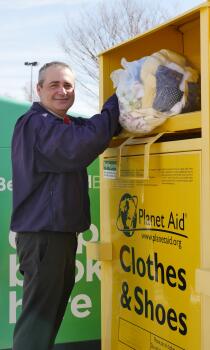A new report published by the Ellen MacArthur Foundation makes the startling claim that a garbage truck full of textiles is being trashed every second. That means in the time it took you to read that last sentence, four garbage trucks, or about 36 tons of usable textiles, have been wasted, gone.
That may be astonishing news to some, but to those of us who have long railed against the increasing wastefulness of the fast fashion industry, it is validation.
The report, A new textiles economy: Redesigning fashion's future, details how the $1.3 trillion fashion industry has been wreaking havoc on the environment. But it also offers a new vision—based on a circular economy—to phase out negative impacts. The promise, which includes support from industry leaders, is to transform the way clothes are designed, sold, and used.
Take, Make, Dispose
 In the last 15 years, clothing production and consumption has doubled. The average consumer purchased 60 percent more clothing in 2014 than in 2000, but garments are only being used half as long. The result is skyrocketing disposal volumes.
In the last 15 years, clothing production and consumption has doubled. The average consumer purchased 60 percent more clothing in 2014 than in 2000, but garments are only being used half as long. The result is skyrocketing disposal volumes.
This problem is a "take-make-dispose" linear system of consumption that pollutes and degrades the environment. Damaging amounts of non-renewable resources, such as oil, fertilizers, and chemicals, are extracted to produce the clothes we buy.
Wasted Too Soon
As recently as 15 years ago, clothing was more of an "investment" for consumers. Today, the average number of times a garment is worn before it's no longer used has plummeted by 36 percent. More than half of the clothing produced is disposed of in under a year. Globally, consumers miss out on an estimated $460 billion of value each year by throwing away clothes that they could continue to wear.
In the United States, clothing disposal rates are among the highest, with some garments discarded after just seven to ten wears. The same pattern has begun to emerge in China, with the utilization rate decreasing by 70 percent over the last 15 years.

The Need for Change
Unless change happens, the negative impacts created by the fashion industry could be disastrous by 2050. Resource consumption could reach 300 million tons and use more than 26 percent of the world's carbon budget.1
The result could be devastating, argues the reports' authors, and is why we must move from the current linear system to one that would increase utilization and create more effective uses of resources. Simply put, we must transform the way clothes are designed, sold, and used.
Transitioning to a Circular Economy
A circular economy is a model that aims to keep products, components, and materials at their highest utility and value. Transitioning from the "take-make-dispose" model to a circular economy would result in a far better utilization of resources. The circular model described in the report relies on four avenues that would lead to better economic, environmental, and social outcomes. These include phasing out substances of concern and the release of microfibers; transforming the way clothes are designed, sold, and used to break away from their current disposable nature; improving recycling; and making effective use of resources.
Some forward-thinking companies have already begun to address the concerns of effects created by the fast fashion industry by taking steps to shift towards a circular economy.
Consumer Responsibility
Consumers have a key role to play in shifting to a circular economy. Rather than regarding clothing as a disposable item, we can embrace a larger vision and understand how our wardrobe choices impact the planet. We can start to change the current mindset and patterns of behavior by adopting practices that help to extend the life of what we purchase, such as repairing and revamping our clothes and storing them properly.

Planet Aid wants to help consumers reduce their clothing impact and improve clothing utilization. Our approach is to increase awareness of the problems of fast fashion and to help communities avoid wasteful disposal. We work with local businesses, governments, and other organizations to place our bright yellow bins in places where they can make it more convenient for consumers to drop off their clothes.
To find a bin near you, click here.
1The carbon budget is the quantity of carbon emissions that will result in global temperatures not exceeding 2 degrees Celsius above pre-industrial levels.

